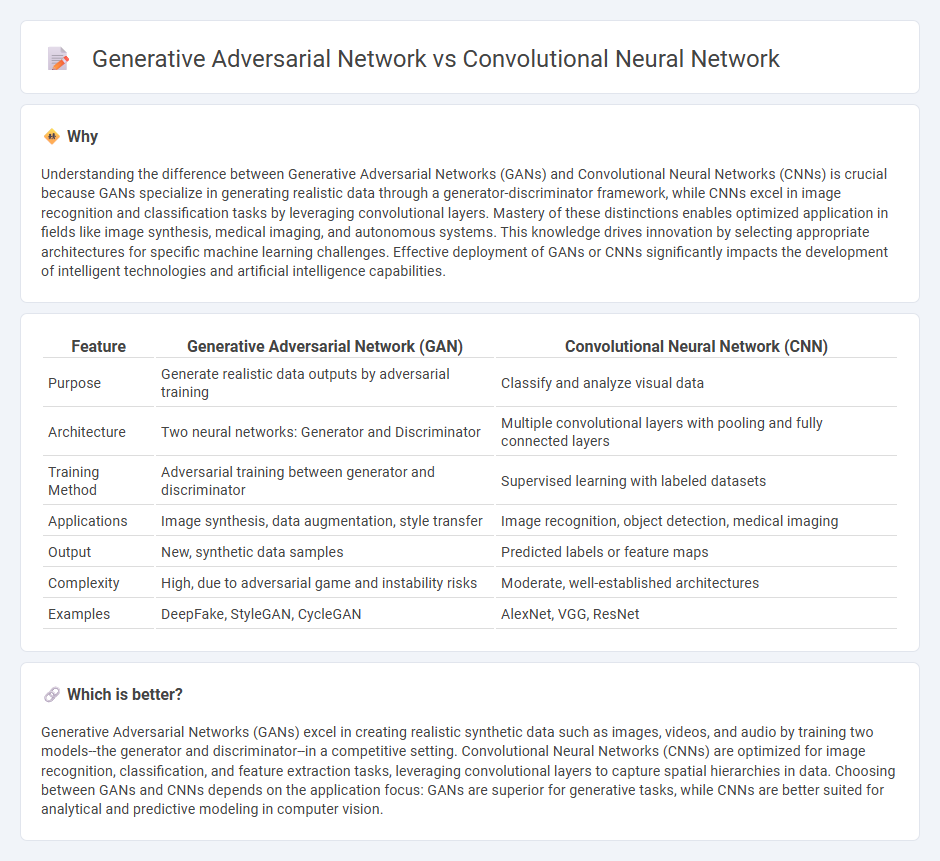
Generative Adversarial Networks (GANs) and Convolutional Neural Networks (CNNs) are distinct deep learning architectures designed for different purposes, with GANs excelling in generating realistic synthetic data and CNNs specializing in image recognition and classification tasks. GANs consist of two neural networks--a generator and a discriminator--that compete to improve data generation quality, whereas CNNs utilize convolutional layers to effectively extract spatial features from images. Explore further to understand how these AI models revolutionize technology through unique applications and advancements.
Why it is important
Understanding the difference between Generative Adversarial Networks (GANs) and Convolutional Neural Networks (CNNs) is crucial because GANs specialize in generating realistic data through a generator-discriminator framework, while CNNs excel in image recognition and classification tasks by leveraging convolutional layers. Mastery of these distinctions enables optimized application in fields like image synthesis, medical imaging, and autonomous systems. This knowledge drives innovation by selecting appropriate architectures for specific machine learning challenges. Effective deployment of GANs or CNNs significantly impacts the development of intelligent technologies and artificial intelligence capabilities.
Comparison Table
| Feature | Generative Adversarial Network (GAN) | Convolutional Neural Network (CNN) |
|---|---|---|
| Purpose | Generate realistic data outputs by adversarial training | Classify and analyze visual data |
| Architecture | Two neural networks: Generator and Discriminator | Multiple convolutional layers with pooling and fully connected layers |
| Training Method | Adversarial training between generator and discriminator | Supervised learning with labeled datasets |
| Applications | Image synthesis, data augmentation, style transfer | Image recognition, object detection, medical imaging |
| Output | New, synthetic data samples | Predicted labels or feature maps |
| Complexity | High, due to adversarial game and instability risks | Moderate, well-established architectures |
| Examples | DeepFake, StyleGAN, CycleGAN | AlexNet, VGG, ResNet |
Which is better?
Generative Adversarial Networks (GANs) excel in creating realistic synthetic data such as images, videos, and audio by training two models--the generator and discriminator--in a competitive setting. Convolutional Neural Networks (CNNs) are optimized for image recognition, classification, and feature extraction tasks, leveraging convolutional layers to capture spatial hierarchies in data. Choosing between GANs and CNNs depends on the application focus: GANs are superior for generative tasks, while CNNs are better suited for analytical and predictive modeling in computer vision.
Connection
Generative Adversarial Networks (GANs) utilize Convolutional Neural Networks (CNNs) as core components to generate high-quality images by learning spatial hierarchies of data. CNNs serve as the discriminator and generator architectures within GANs, enabling effective feature extraction and synthesis through convolutional layers. This connection allows GANs to produce realistic visuals by leveraging CNNs' ability to recognize and replicate intricate patterns in image data.
Key Terms
Feature Extraction
Convolutional Neural Networks (CNNs) excel in feature extraction by hierarchically learning spatial hierarchies from images through convolutional layers, enabling precise recognition of patterns such as edges, textures, and shapes. Generative Adversarial Networks (GANs), while primarily designed for data generation, incorporate feature extraction implicitly through their discriminator networks, which learn to distinguish real from generated data based on extracted features. Explore more to understand how these architectures leverage feature extraction for diverse applications in computer vision and image synthesis.
Generator-Discriminator
Convolutional Neural Networks (CNNs) excel in feature extraction through layered convolutions, primarily used for image recognition and classification tasks, while Generative Adversarial Networks (GANs) comprise two neural networks--the Generator creates synthetic data, and the Discriminator evaluates its authenticity. The Generator-Discriminator dynamic in GANs involves continuous adversarial training, where the Generator improves output realism to fool the Discriminator, and the Discriminator enhances its ability to differentiate real from fake data, driving both networks to evolve. Explore further to understand how this interplay enables powerful applications in image synthesis and data augmentation.
Image Synthesis
Convolutional Neural Networks (CNNs) excel at feature extraction and image classification, making them effective for tasks like image recognition and enhancement, but they are limited in generating new images from scratch. Generative Adversarial Networks (GANs) consist of a generator and discriminator working in tandem to create highly realistic synthetic images, revolutionizing image synthesis by learning data distributions without explicit feature engineering. Explore how the unique architectures of CNNs and GANs drive advancements in realistic image synthesis.
Source and External Links
What are Convolutional Neural Networks? - Convolutional neural networks (CNNs) are a type of neural network primarily used for image classification and object recognition, leveraging matrix multiplication to identify patterns in images with nodes arranged in input, hidden, and output layers.
An Introduction to Convolutional Neural Networks (CNNs) - CNNs are deep learning algorithms specialized in object recognition tasks like image classification and can autonomously extract features from large-scale data without manual engineering, offering translation-invariant pattern extraction useful in many applications.
Convolutional neural network - A CNN is a feedforward neural network that learns features through filter optimization and is widely applied in image recognition, medical imaging, NLP, and more, characterized by shift-invariant architecture inspired by biological vision processing.
 dowidth.com
dowidth.com